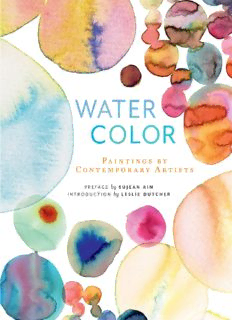
Watercolor Paintings of Contemporary Artists PDF
Preview Watercolor Paintings of Contemporary Artists
WATER COLOR PAINTINGS BY CONTEMPORARY ARTISTS PREFACE by SUJEAN RIM INTRODUCTION by LESLIE DUTCHER CONTENTS 6 Preface by SUJEAN RIM 9 Introduction by LESLIE DUTCHER 20 Dear Hancock 28 Julia Denos 36 Danny Gregory 44 Samantha Hahn 52 Virginia Johnson 58 Anna Emilia Laitinen 66 Daire Lynch 72 Fabrice Moireau 80 Jane Mount 88 Amy Park 96 Cate Parr 104 Isadora Reimão 110 Sujean Rim 116 Amy Ross 124 José Seligson 132 Becca Stadtlander 140 John Norman Stewart 148 Paolo Terdich 154 Tamara Thomsen 160 Jenny Vorwaller 166 Hannah Ward 172 Artist Bios 176 Resources Flirt, 2012 Watercolor 14 × 12 in. (36 × 30 cm) Preface by Sujean Rim Watercolor is such a flirt. The way it suggests form with sheer washes of color. The way it plays with light and depth with splashes of water. The way it can tease the eye by capturing realism until you notice shapes bleeding. With watercolor, there are no perfect lines. There are many fewer rules than with other art forms, and there is no time to overthink. Once your wet brush hits dry paper, you’re done—and there is no undoing what you’ve committed your brush to. And no matter what bag of tricks or techniques you may have developed, you are never quite in complete control. As an artist, it can feel frustrating to not have that control. But if you allow watercolor to just do its thing—and stay open to those inevitable happy accidents, whereby colors leak into each other or your brush runs dry in the middle of a stroke—the most beautiful things can happen. The not-always-knowing-what-to-expect feeling that this medium sparks is what I find the most fun—it’s what keeps me curious. You may never truly get to know your watercolor, but you can flirt back. My first encounters with watercolor were probably much like yours. Childhood memories of painted fingers, splattered smocks, rolls of white paper, old coffee cans full of dyed water, and fat friendly brushes come to mind. It was fun, but I wasn’t all that smitten just yet. Crayons, glitter and glue, and Play-Doh were just as impressive. It wasn’t until I watched my father ceremoniously take out an old handsome lacquer box of sumi-e black ink and beautiful bamboo brushes that I really took notice. He would paint Korean and Japanese calligraphy onto soft and translucent white paper with this incredible black and syrupy ink. I could feel his thoughtful concentration. Each brushstroke was confident and each had purpose. When I asked if I could pleeaasse try those awesome brushes and ink, I was always turned down and told, “Someday.” I knew they had to be something special. I later took closer notice of the old Korean landscape paintings around our house. They were on pretty silk scrolls hanging from wooden dowels. You probably have seen something similar at your favorite Asian restaurant. No matter the quality, I found these images of mountains, water, and nature to be increasingly beautiful, and I started to wonder, “How did they do that? How did they paint those peony petals to look so real and delicate, or those mountains to look so grand?” Soon I would come to admire more styles of watercolor. Among my first inspirations was Charles Schulz (yes, the creator of the cartoon dog Snoopy). I received a big art book of his work that showcased some of the beautiful watercolor backgrounds he painted for his comic strip, Peanuts. These artworks, like the Asian ones I had grown up with, also employed visions of nature. Whether it was an autumn scene with piles of colorful foliage or a snow-filled winter landscape, each depiction captured so much feeling, yet with little detail. These paintings appeared so loose in their renderings. You could see droplets of water, you could see gradations of color blending into each other. And the use of the negative space of the paper fascinated me—a small unpainted area in a wash of blue suddenly became a cloud in the sky. In art school I was able to experiment with lots of media. I tried oils and acrylics, but I felt lost and overwhelmed in the world of linseed oils and varnishes. I would always come back to watercolor. And I still return to it—maybe because of the simplicity of needing only water to paint, or maybe because I simply love to sketch. I love the spontaneity of capturing an image. It is pure, honest energy and emotion—there’s no struggling, no worrying for perfection in a sketch. Painting with watercolor has that sense of immediacy—you are working with wet and running color, so you have to get your brushstrokes down quickly. There’s not much time to think or agonize, so in the end you hopefully can just enjoy the ride. When asked what medium I use, it is not surprising to hear, upon giving my response, a polite “Oh, watercolor. That’s so sweet.” Or “Now, I have a friend who paints with oil.” Maybe it is because we have childhood memories of those splattered smocks that I mentioned before, but to those who question watercolor’s sophistication, I would have them take a look at works by Winslow Homer or Andrew Wyeth. For breadth of style, I say look at Charles E. Burchfield, J. W. S. Cox, Mats Gustafson . . . and just take a look at this book. I’m certainly smitten.
Description: